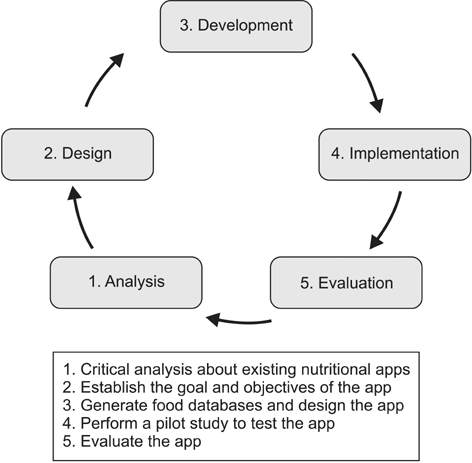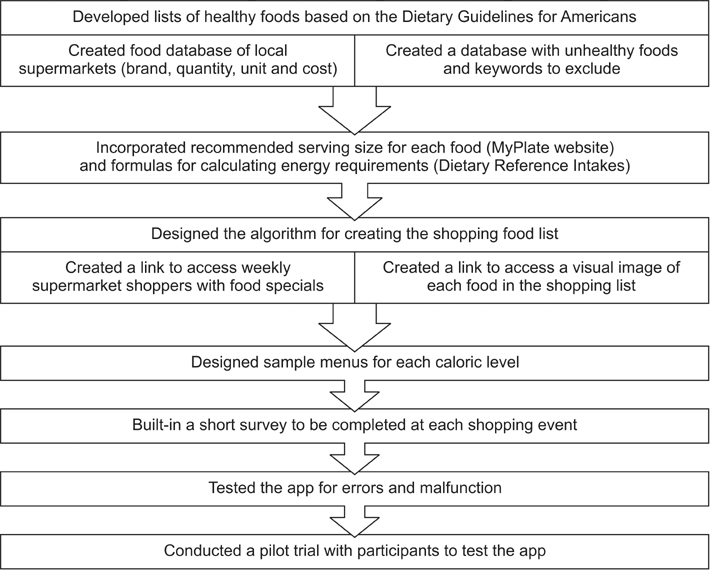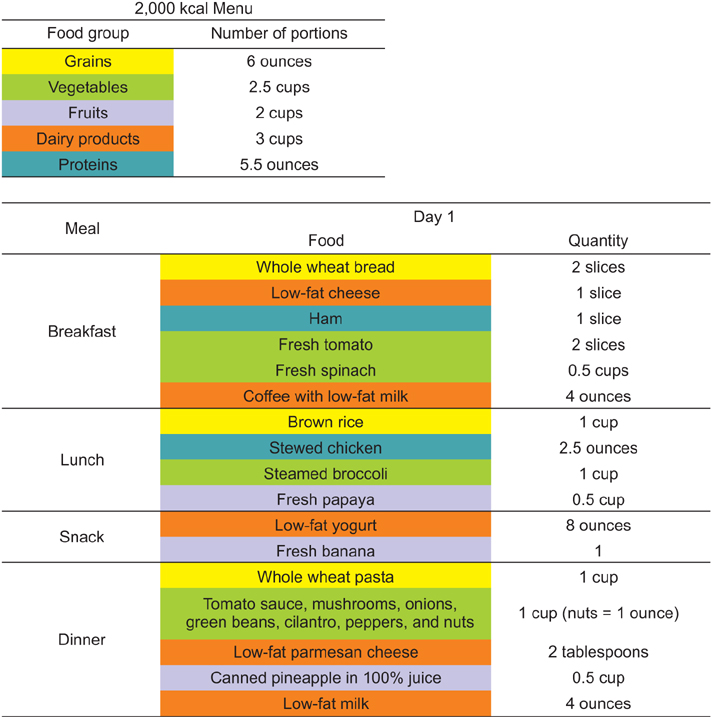Healthc Inform Res.
2017 Jan;23(1):16-24. 10.4258/hir.2017.23.1.16.
Development and Evaluation of a Nutritional Smartphone Application for Making Smart and Healthy Choices in Grocery Shopping
- Affiliations
-
- 1Nutrition Program, Graduate School of Public Health, Medical Sciences Campus, University of Puerto Rico, San Juan, Puerto Rico. cristina.palacios@upr.edu
- 2Akcelita Innovation Labs, San Juan, Puerto Rico.
- 3Department of Biostatistics and Epidemiology, Graduate School of Public Health, Medical Sciences Campus, University of Puerto Rico, San Juan, Puerto Rico.
- KMID: 2368981
- DOI: http://doi.org/10.4258/hir.2017.23.1.16
Abstract
OBJECTIVES
This study developed a smartphone nutritional application (app) for making smart and healthy choices when purchasing food in grocery stores and tested its feasibility, usability, satisfaction and acceptability.
METHODS
"MyNutriCart" was developed following the ADDIE (analysis, design, development, implementation, and evaluation) model. The goals of the app were to improve food selection when purchasing foods in the grocery stores based on a pre-defined budget, to improve dietary patterns based on the Dietary Guidelines for Americans, and to improve weight status. It was evaluated within a pilot randomized trial using a convenient sample of 26 overweight or obese adults aged 21-45 years for 8 weeks.
RESULTS
The developed app provided a grocery list of healthy foods to meet the individual requirements of all family members within a budget following the recommendations of the Dietary Guidelines for Americans. The average use of the app was 75% on each purchase and only 37% of the recommended products were purchased. The main reasons for not purchasing the recommended items were that participants did not like these (28.5%) and that the item was unavailable in the supermarket (24.3%). Over 50% of participants considered the app as feasible, usable, satisfactory, and acceptable (p < 0.05).
CONCLUSIONS
"MyNutriCart" is the first available app for making smart and healthy choices when purchasing food in grocery stores. This app could be used as a tool to translate recommendations into a practical grocery list that meet the needs of a family within a budget.
Keyword
MeSH Terms
Figure
Reference
-
1. National Agricultural Library. DRI nutrient reports [Internet]. Beltsville (MD): National Agricultural Library;c2016. cited at 2017 Jan 3. Available from: https://www.nal.usda.gov/fnic/dri-nutrient-reports.2. Mozaffarian D, Appel LJ, Van Horn L. Components of a cardioprotective diet: new insights. Circulation. 2011; 123(24):2870–2891.3. Guilbert JJ. The world health report 2002: reducing risks, promoting healthy life. Educ Health (Abingdon). 2003; 16(2):230.4. Centers for Disease Control and Prevention. BRFSS prevalence & trends data: explore by location [Internet]. Atlanta (GA): Centers for Disease Control and Prevention;c2017. cited at 2017 Jan 3. Available from: http://www.cdc.gov/brfss/brfssprevalence/.5. Mayo Clinic. Risk factors of obesity [Internet]. Scottsdale (AZ): Mayo Clinic;2015. cited at 2017 Jan 3. Available from: http://www.mayoclinic.org/diseasesconditions/obesity/basics/risk-factors/con-20014834.6. US Department of Agriculture. Dietary Guidelines for Americans 2015-2020 [Internet]. Washington (DC): US Department of Agriculture;2015. cited at 2017 Jan 3. Available from: http://health.gov/dietaryguidelines/2015/guidelines/executive-summary/.7. Office of Disease Prevention and Health Promotion. Eat healthy, be active community workshops [Internet]. Rockville (MD): Office of Disease Prevention and Health Promotion;2012. cited at 2017 Jan 3. Available from: http://www.health.gov/dietaryguidelines/workshops/DGA_Workshops_Complete.pdf.8. Guenther PM, Kirkpatrick SI, Reedy J, Krebs-Smith SM, Buckman DW, Dodd KW, et al. The Healthy Eating Index-2010 is a valid and reliable measure of diet quality according to the 2010 Dietary Guidelines for Americans. J Nutr. 2014; 144(3):399–407.
Article9. Fitriana N, Madanijah S, Ekayanti I. Analysis of media use in the nutrition education on knowledge, attitude and practice of the breakfast habits on elementary school students. Pak J Nutr. 2015; 14(6):335–345.
Article10. Bello Lujan LM, Armas Navarro A, Jimenez Suarez M, Hernandez Betencourt L, Serra Majem L. Nontraditional nutrition education interventions: the radio ECCA method. Eur J Clin Nutr. 2003; 57:Suppl 1. S86–S89.
Article11. Lieffers JR, Vance VA, Hanning RM. Use of mobile device applications in Canadian dietetic practice. Can J Diet Pract Res. 2014; 75(1):41–47.
Article12. McGriff SJ. Instructional System Design (ISD): using the ADDIE model [Internet]. State College (PA): College of Education, Penn State University;2000. cited at 2017 Jan 3. Available from: https://www.lib.purdue.edu/sites/default/files/directory/butler38/ADDIE.pdf.13. US Department of Agriculture. Dietary Guidelines for Americans 2010 [Internet]. Washington (DC): US Department of Agriculture;2010. cited 2017 Jan 3. Available from: http://health.gov/dietaryguidelines/dga2010/dietaryguidelines2010.pdf.14. Academy of Nutrition and Dietetics. Adult Weight Managemetn (AWM) guideline: major recommendations (2014) [Internet]. Chicago (IL): Academy of Nutrition and Dietetics;2015. cited at 2017 Jan 3. Available from: http://www.andeal.org/vault/pq132.pdf.15. Colon-Lopez V, Banerjee G, Gertz AM, Ortiz AP, Calo W, Finney-Rutten LJ, et al. Behavioral correlates of fruit and vegetable intake in Puerto Rico: results from the Health Information National Trends Survey. P R Health Sci J. 2013; 32(4):194–199.16. Kimmons J, Gillespie C, Seymour J, Serdula M, Blanck HM. Fruit and vegetable intake among adolescents and adults in the United States: percentage meeting individualized recommendations. Medscape J Med. 2009; 11(1):26.17. Torres R, Santos E, Orraca L, Elias A, Palacios C. Diet quality, social determinants, and weight status in Puerto Rican children aged 12 years. J Acad Nutr Diet. 2014; 114(8):1230–1235.
Article18. Krolner R, Rasmussen M, Brug J, Klepp KI, Wind M, Due P. Determinants of fruit and vegetable consumption among children and adolescents: a review of the literature. Part II: qualitative studies. Int J Behav Nutr Phys Act. 2011; 8:112.
Article19. Hollywood LE, Cuskelly GJ, O'Brien M, McConnon A, Barnett J, Raats MM, et al. Healthful grocery shopping: perceptions and barriers. Appetite. 2013; 70:119–126.
Article20. Wiig K, Smith C. The art of grocery shopping on a food stamp budget: factors influencing the food choices of low-income women as they try to make ends meet. Public Health Nutr. 2009; 12(10):1726–1734.
Article21. Ball K, Mouchacca J, Jackson M. The feasibility and appeal of mobile ‘apps’ for supporting healthy food purchasing and consumption among socioeconomically disadvantaged women: a pilot study. Health Promot J Austr. 2014; 25(2):79–82.
Article22. Carter MC, Burley VJ, Nykjaer C, Cade JE. Adherence to a smartphone application for weight loss compared to website and paper diary: pilot randomized controlled trial. J Med Internet Res. 2013; 15(4):e32.
Article23. Oliver E, Banos RM, Cebolla A, Lurbe E, Alvarez-Pitti J, Botella C. An electronic system (PDA) to record dietary and physical activity in obese adolescents: data about efficiency and feasibility. Nutr Hosp. 2013; 28(6):1860–1866.
- Full Text Links
- Actions
-
Cited
- CITED
-
- Close
- Share
- Similar articles
-
- Factors influencing consumers’ continuance intention in online grocery shopping: a cross-sectional study using application behavior reasoning theory
- The Development and Application Effects of a Fatigue Self-Care Smartphone Application for Lung Cancer Patients Receiving Chemotherapy
- Developing a Smart Phone Application for the OMAHA System Guidelines
- Predictors of Habitual and Addictive Smartphone Behavior in Problematic Smartphone Use
- Development of 'Children's Food Avatar' Application for Dietary Education





